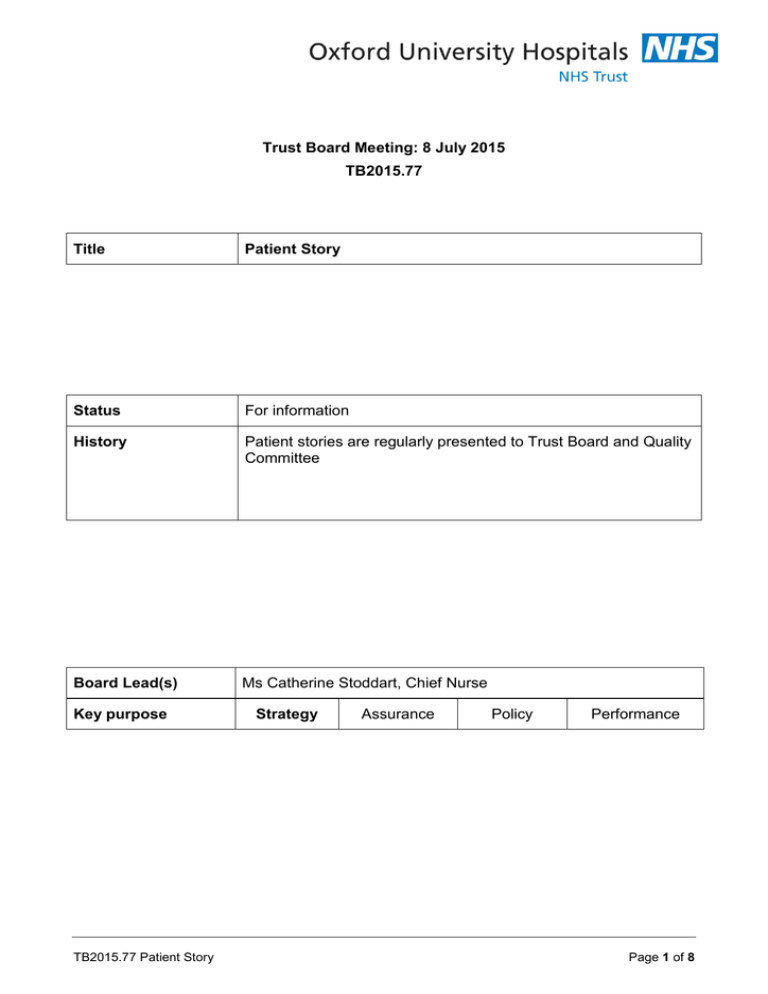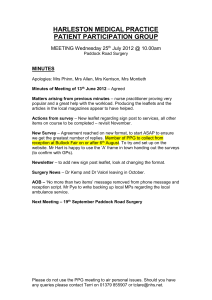Trust Board Meeting: 8 July 2015 TB2015.77 Title
advertisement

Trust Board Meeting: 8 July 2015 TB2015.77 Title Patient Story Status For information History Patient stories are regularly presented to Trust Board and Quality Committee Board Lead(s) Ms Catherine Stoddart, Chief Nurse Key purpose TB2015.77 Patient Story Strategy Assurance Policy Performance Page 1 of 8 Oxford University Hospitals TB2015.77 Executive Summary 1. The purpose of this paper is to tell the recent story of Mrs S and her experience of bowel surgery at the Churchill Hospital. The story was related by her husband and also provides a carer perspective. 2. This positive story provides an important opportunity to • Recognise and celebrate good practice, the excellent care provided and behaviours aligned with the Trust Values. • Raise awareness of positive patient and carer experience. • Appreciate the many acts of individual compassionate, person-centred care that contributed to this positive patient and carer experience. Reflect on the importance of ensuring that the communication infrastructure best supports patients and carers at every point on their journey. 3. Recommendation: 3.1. The Trust Board is asked to read and reflect on the patient story and acknowledge the learning. TB2015.77 Patient Story Page 2 of 8 Oxford University Hospitals TB2015.77 Patient Story 1. Purpose 1.1. 2. The purpose of this paper is to tell the Mrs S’s story of her admission for bowel surgery in May 2015 and the experience of her husband in supporting and caring for her1. Background and context to the patient story 2.1. The Patient Experience Team produced this story with Mr S and the Deputy Lead Cancer Nurse. Mrs S had shared her story with Mr S prior to the meeting, but was unable to attend due to still recovering from her surgery. All the quotes are from Mr S’s interview – either in his own words or recounting Mrs S’s words. 2.2. This story describes compassion from two standpoints; clinical care and organisation. 2.3. It portrays the importance of person-centred, high quality care and the impact of sensitive and intuitive clinical support upon a patient’s personal preparation for a procedure or admission. Mr S conveyed clearly the reassurance both he and his wife felt when their vulnerability was recognised by clinical and non-clinical staff at all levels who went the “extra mile” to support and calm them. “The people involved all conveyed a positive interest in me.” Mrs S 3. 2.4. The positive impact of clear and full communication with patients and the effect on their care is reinforced throughout Mr and Mrs S story. 2.5. It also illustrates the anxiety which can be caused by systems not working as they should; leaving families with no clear way of finding out information about their relatives’ wellbeing. 2.6. The presentation of patient stories gives an opportunity to represent real life examples of the Trust’s values in action, both from a positive and negative standpoint. This story gives the whole Trust and opportunity to reflect on our clinical and non-clinical work with patients and their families; and the critical role we all play in supporting healthcare to run smoothly. Pre-operative meeting and procedures 3.1. Mrs S came into the John Radcliffe Hospital with her husband for a preoperative meeting the week before her operation, where they waited for a short time in the Blue Area before being seen by a nurse. 3.2. Mr S described the nurse they saw as “5-star”. Mr S noticed that his wife was very anxious initially and saw that her hands were shaking at the beginning of the consultation. However, the nurse “picked up her anxiety immediately – and also noticed that I had a hearing aid”. He described how his wife gradually felt more at ease and her shaking stopped as the consultation progressed. 1 https://www.gov.uk/government/uploads/system/uploads/attachment_data/file/366089/Factsheet_8__Carers.pdf TB2015.77 Patient Story Page 3 of 8 Oxford University Hospitals 4. TB2015.77 3.3. The nurse asked Mrs S if she was concerned about anything and Mrs S said that she was worried about the laparoscopy (keyhole surgery) 2. In order to alleviate her fears the nurse asked the consultant to come and see her. The consultant spent some time explaining the operation and Mrs S felt that her worries were alleviated. Mr S noticed that all the time, the nurse kept a very close eye on his wife to ensure she was feeling less anxious 3. 3.4. A few days later, the nurse phoned to say that the surgery had been put forward and Mrs S needed to come in and collect her pre-operative kit 4 5. 3.5. During the telephone conversation Mrs S recalled that the nurse again recognised that she was feeling anxious and asked her if she’d like to meet the surgeon when she picked up her kit. Mr S commented how relieved his wife felt later on after she met the surgeon who would be undertaking the operation, his compassionate attitude and how much she valued the time he spent time discussing her operation. 3.6. Mrs S started the pre-operative procedure at home but found it quite difficult to follow precisely. She is a smaller framed woman and had recently lost weight and at one point Mrs S was feeling so bad that she nearly fainted and had to stop the procedure in order to sleep for a couple of hours. 3.7. Mr S felt that following his wife’s experience the pre-operative kit should be adapted for different sized people and with clearer instructions. Surgery 4.1. Mrs S was admitted on a Friday before a bank holiday weekend. She was told when she arrived that there was a case before her and that her operation would be delayed. 4.2. As it was going to be a long wait, the hospital staff said that it would be advisable for Mr S to go home and phone later to see how his wife’s operation had gone. Mr S was told he could call up until 10.30pm on a specified number to get news of his wife’s operation and how she was. Mr S phoned that night but was unable to get through on the number given as no one answered the telephone and he had no way of leaving a message. He was frustrated and worried as he was very concerned about his wife and wanted to hear the outcome of the operation. 4.3. He tried several times on this number and then decided to call the main hospital switchboard. Mr S described how well his call was handled. He explained to the switchboard operator that he “was nearly 83 and that he would not be able to sleep unless he was able to find out how his wife’s operation had gone.” Her attitude was compassionate and she asked if he didn’t mind waiting while she 2 3 http://www.nhs.uk/conditions/laparoscopy/pages/introduction.aspx http://www.nursingtimes.net/Journals/2012/11/22/l/j/s/121127-surgery-anxiety.pdf 4 A pre-operative kit includes a skin preparation to reduce the risk of infection as well as substances to empty the bowel and for rehydration. The pre-operative kit is part of the Enhanced Recovery Service which is a programme led by a specialised nurse. The programme covers pre, during and post-operative points, ensuring that there is a structured care plan in place to provide fluids and analgesia at the optimum times for patient comfort and recovery. 5 http://www.nhs.uk/conditions/enhanced-recovery/Pages/Introduction.aspx TB2015.77 Patient Story Page 4 of 8 Oxford University Hospitals TB2015.77 found out where his wife was, offering a choice of music to listen to while he waited. After a couple of minutes, the switchboard operator told Mr S that his wife had just gone into the Recovery Ward and gave him the number to call6. “I said that if I could send her (the receptionist) a gold star down the telephone, I would. She said that gold stars have to be earned in heaven”. Mr S 4.4. Mr S spoke to someone on the Recovery Ward just after 11pm and was told that his wife’s operation had gone smoothly and that his wife was going to be transferred to Lower Gastro Intestinal (Lower GI) Ward. 5. Post operation and discharge 5.1. The next morning Mr S phoned Lower GI ward and was again reassured that his wife was fine and was informed of the visiting times. 5.2. When he visited that afternoon, Mr S was pleased to see that his wife was sitting in a chair, not in bed and she said she had had a reasonable sleep 7. 5.3. Mrs S described to her husband how anxious she had felt about having an epidural but that the anaesthetist had put her at her ease. He recognised her anxiety and gave her some medication to calm her prior to the epidural. Mrs S also described the friendly chat she had had with the anaesthetist that morning after the operation. This care and attention helped her to feel ‘looked after’. 5.4. Mrs S was impressed by the comprehensive post-operative history taken that morning by the consultant. They were also impressed by the nursing team and especially by the support provided to ensure she was walking independently as soon as possible 8. On the day following the operation she walked around the ward and by Sunday was walking round the whole ward without assistance. The nurses constantly fed back to Mrs S on how well she was doing which in turn motivated her and again helped her feel that the team were doing all they could to assist in her recovery and to support her getting home as soon as possible. “My wife and I both have experience in health care – she was a GP and I was a management consultant working in health. We found all the team very good. Lower GI is extremely well organised and totally digitalised so it was easy for all those involved with my wife’s care to be up to speed on her condition. It was clear that the staff had clear direction. We were sorry not to have met the nurse in charge to feed back our positive experiences personally.” Mr S 5.5. As a carer Mr S felt supported and “fully in the picture”. One example of this is that Mrs S was going to be discharged on Tuesday but she was concerned that Mr S was very tired and needed to rest before she came home 9. Therefore it was arranged that discharge would take place the following day 10. 6 Delivering high quality, effective, compassionate care: Developing the right people with the right skills and the right values: A mandate from the Government to Health Education England: April 2015 to March 2016 https://www.gov.uk/government/uploads/system/uploads/attachment_data/file/411200/HEE_Mandate.pdf 7 http://www.nhs.uk/Conditions/surgery/Pages/after-surgery.aspx 8 http://www.nhs.uk/Conditions/surgery/Pages/getting-back-to-normal.aspx 9 https://www.gov.uk/government/uploads/system/uploads/attachment_data/file/329867/Carers_Pathway.pdf 10 http://www.england.nhs.uk/commissioning/comm-carers/ TB2015.77 Patient Story Page 5 of 8 Oxford University Hospitals TB2015.77 5.6. Mrs S’ discharge was smooth and her package of medicines was ready so there were no delays in going home 11. Mr S noted that drugs were packaged up carefully. 6. Learning 6.1. Mr and Mr S raised some important and thought provoking points about their care. Their overall experience was positive although there were two aspects of care and organisation which initially did not go well. 6.2. The positive impact on a patient and their family of compassionate care throughout a patient’s journey cannot be underestimated. This was demonstrated well in Mr S interaction with the switchboard operator and Mrs S support from the preoperative nurse and anaesthetist. They all demonstrated the resourcefulness and compassion to adapt their support for the couple. The switchboard operator particularly demonstrated the importance of listening during a telephone conversation, recognising Mr S distress and helping him to contact the ward to establish how his wife was following her surgery. It is a salient lesson for staff to remember the size of the organisation and the vulnerability of patients and their families when systems don’t work as they should. 6.3. The experience of anxiety prior to surgery is well known and has been highlighted above. The clinicians supported Mr and Mrs S in a ‘low key’ manner, clearly recognising Mrs S anxiety and helping her prepare for surgery. The team enabled her to discuss her fears with both the surgeon and anaesthetist and therefore empowered her. 6.4. The way in which their negative experiences were supported and resolved clearly helped them to still feel positive about Mrs S surgery. The clinical and administrative staff involved demonstrated person centred flexibility and adaptability to enable the couple to have confidence and trust their input and care. 6.5. The Deputy Lead Cancer Nurse will discuss the couple’s positive feedback with the team and the individuals who were mentioned by name. 6.6. The Deputy Lead Cancer Nurse has explored the two less positive issues that were raised in this story. 6.6.1. The first issue was that the pre-operative kit seemed too large for a smaller person. Feedback from the Pre-operative Assessment Service confirmed that the carbohydrate drinks are standard for all patients, although sometimes is the amount of laxatives given is varied. The comments from this patient will be fed back to the Preoperative Team and to the Enhanced Recovery Facilitator. 6.6.2. The second issue was around the difficulties for Mr S contacting the hospital after his wife’s operation. The Theatre Sister explained “Quite often the patients that are late going into theatre are still in recovery when the unit closes and recovery do want their phone numbers given out. 11 http://www.nhs.uk/NHSEngland/AboutNHSservices/NHShospitals/Pages/leaving-hospital.aspx TB2015.77 Patient Story Page 6 of 8 Oxford University Hospitals TB2015.77 I will discuss in our ward meeting how to improve this process and discuss with recovery managers as well. It may be that we change the system so that we ask relatives to call switch board and to be put through to recovery after the unit closes. I will also change the answer phone message in accordance. Please give the gentleman my apologies, and thank him for giving feedback so that we can try to improve our service.” 6.7. The learning from this story will be shared on the Delivering Compassionate Care Course as an excellent example of behaviours that align with the Trust values. 6.8. The Patient Experience Team is very grateful to Mr and Mrs S and the Cancer Team for sharing their experiences and learning in the production of this story. 7. Recommendations 7.1. The Trust Board is asked to read and reflect on the patient story and acknowledge the learning. Catherine Stoddart Chief Nurse Authors Rachel Taylor, Public Engagement and Patient Experience Manager Caroline Heason, Head of Patient Services 26 June 2015 TB2015.77 Patient Story Page 7 of 8 Oxford University Hospitals TB2015.77 Appendix 1: Behaviours alignment with Trust Values Evidence Mr S noted that he felt his wife was very anxious initially and saw that her hands were shaking at the beginning of the consultation. However, he felt that the nurse “picked up her anxiety immediately – and also noticed that I had a hearing aid”. The nurse asked Mrs S if she was concerned about anything and Mrs S said that she was worried about the laparoscopy (keyhole surgery). In order to alleviate her fears the nurse asked the consultant to come and see her. The consultant spent some time explaining the operation and Mrs S felt that her worries were alleviated. Mr S noticed that all the time, the nurse kept a very close eye on his wife to ensure she was feeling less anxious. During the telephone conversation Mrs S recalled that the nurse again picked up that she was feeling anxious and asked her if she’d like to meet the surgeon when she picked up her kit. The receptionist attitude was compassionate and she asked him if he didn’t mind waiting while she found out where his wife was. He was offered a choice of music to listen to while he waited. After 2-3 minutes, the receptionist told Mr S that his wife had just gone into Recovery Ward and gave him a number to call. “I said that if I could send her (the receptionist) a gold star down the telephone, I would. She said that gold stars have to be earned in heaven”. Mr S Mrs S described to her husband how anxious she had been about having an epidural but that the anaesthetist had put her at her ease. He recognised her anxiety and gave her something to calm her down prior to the epidural. Mr S was told he could call up until 10.30pm on a specified number to get news of his wife. Mr S phoned that night but was unable to get through on the number given and had no way of leaving a message on this line which was frustrating as he was very concerned about his wife and wanted to hear how the operation had gone. The Deputy Lead Cancer Nurse is looking into the two less positive issues that were raised in this story. TB2015.77 Patient Story Value Compassion Aligned Behavioural Indicator You take the time and effort to understand people and their situations and do everything you can to care for them. Respect You recognise everyone as an individual and tailor your approach to meet their particular needs. Compassion You value and acknowledge the experiences of other people. Compassion You go the extra mile for your colleagues and/or patients. Delivery You focus on delivering high standards in your work at all times. You do what you’ll say you do. Excellence You’re a role model for the organisation and you inspire other people by example. Compassion You see things from the patient and family’s perspective and always put their needs first. Delivery You communicate openly and honestly when things go wrong and take responsibility for making changes. Learning You reflect on your mistakes and learn from them. You work alongside others to identify ways to avoid mistakes in the future. Page 8 of 8



